
Search jobs
Help to shape the digital future of one of the world’s best-loved brands.
As Miele X continues to grow at an incredible pace, the introduction of standard processes and quality control becomes more and more important. We asked Seb Gevers, Head of QA and Johannes Henkie, Senior QA Engineer about the exciting challenges of developing and implementing an adaptable, leading-edge test automation framework to support all these new developments.
Seb was born in the Netherlands, but grew up in Scotland and also lived in Ireland. He worked for a number of established and start-up organisations, including Siebel (now Oracle), EDS and CSC, before joining Miele X in 2022. Johannes grew up in Indonesia and moved to the Netherlands, where he worked for International Card Services by ABN AMRO, before joining Miele X in 2021.

Seb starts by explaining why Miele X needed to introduce automated functional testing. “The business is growing so fast, that we need to be able to do testing in a repeatable and scalable way,” he says. “An automated testing framework is like the scaffolding on a building. It supports all the different business processes. And having this strong, structured framework for testing allows us to continue building upwards as the business develops and grows.”
Johannes adds that this is important because Miele X is a constantly evolving business. “There are new challenges all the time,” he says. “That’s why having a strong foundation and structure is really important. Because it allows us to adapt to business expansion.”
An advanced solution that’s right for the business
After looking at the pros and cons of Cypress and Selenium, they chose a Cypress automated testing framework. Johannes describes it as “a one-stop solution that can integrate with lots of different things. And that’s really important for an evolving business like Miele X.”
They also introduced the Cucumber testing tool, which allows testing to be written in a language that anyone can understand. Seb explains that this is really useful at Miele X: “Cucumber aids collaboration, so it adds a lot of business value, because the developers and the business teams can work together to build reliable test cases. This helps the developers to understand what the users want and translate it into the right code.”
Being agile to adapt to big challenges
One of the key criteria they were looking for in the automated testing framework was adaptability. Seb explains why: “The business is so diverse, operating in many different markets, and it’s expanding and evolving fast. We have so many challenges, from new products and the release of new features, to diverse requirements in different markets and they all affect the testing framework. The big challenge is the time to market. To get a new message into the market about any new product or feature, we need to move fast.”
Johannes agrees. “Automating this whole process means we can run testing multiple times,” he says. “And we’re looking at running automated testing in tandem with our development sprints.”
The freedom to try new tools
Johannes adds that this gives his team a lot of opportunities to experiment with different tools. “Because Miele X is still growing and our needs are evolving, we need to look out for the best tools and the best ways of working that suit our purpose. So, in my team, you have the freedom to try out new tools and see how they work. There’s no fear of failure, because that’s how you learn.”
Seb points out that ultimately, they want to be able to run the framework alongside the developments in a single process. “We’re aiming to significantly reduce our regression testing times from several days to one that can be run overnight on every build”, he says. “This will really help our time to market and add genuine value to the business. That’s why this framework is so exciting and so unique.”
An environment of innovation
They’re both passionate about the opportunities for innovation at Miele X. For Seb, it’s down to the agile way of working in the development teams, which means everything moves faster. And this means the testing processes need to move faster, too.
“That’s what makes our work so exciting,” he says. “We’re adapting to new challenges and developing the framework alongside new developments. It’s about looking at different tools, trying them out and deciding which one’s best for our needs. So, it’s pioneering work, constantly learning, adapting and applying new ideas.”
What’s next? You decide. Join our IT team and help shape the future of our iconic brand. Check out our latest opportunities.